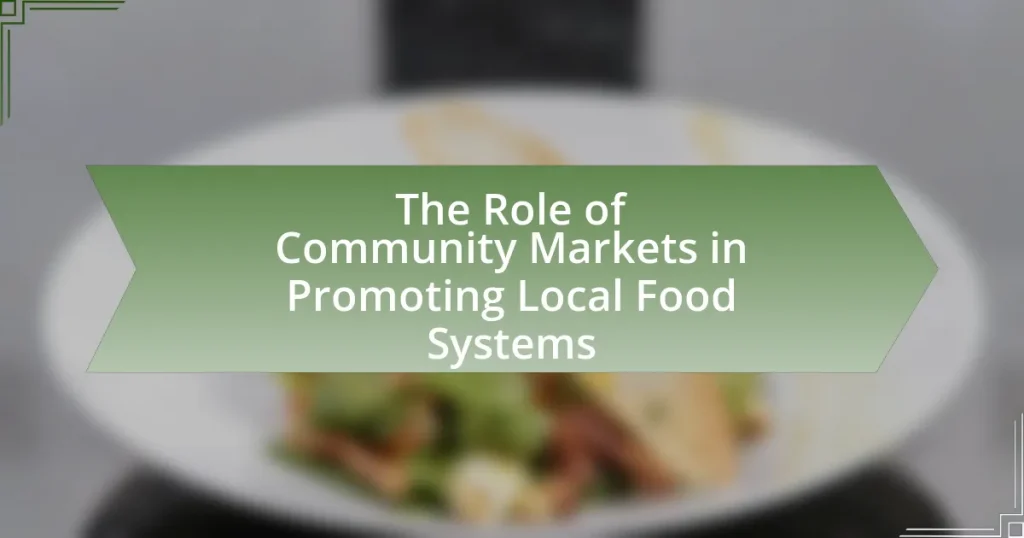Community markets serve as local marketplaces where producers sell goods directly to consumers, playing a crucial role in promoting local food systems. They enhance food security, improve access to healthy options, and support local economies by fostering connections between farmers and the community. The article explores how community markets function within local food systems, the types of products they offer, their economic benefits, and their impact on job creation. Additionally, it addresses challenges faced by these markets, strategies for overcoming financial obstacles, and best practices for establishing successful community markets. Through various initiatives, community markets not only promote sustainable agricultural practices but also enhance community engagement and address food accessibility issues.

What are Community Markets and Their Purpose?
Community markets are local marketplaces where producers sell their goods directly to consumers, fostering connections between local farmers and the community. Their purpose is to promote local food systems by providing a platform for fresh, locally-sourced products, which supports local economies and encourages sustainable agricultural practices. Research indicates that community markets can enhance food security and improve access to healthy food options, as they often feature seasonal produce and artisanal products.
How do Community Markets function within local food systems?
Community markets function as vital components of local food systems by facilitating direct connections between local producers and consumers. These markets enable farmers and artisans to sell their products directly to the community, thereby reducing the supply chain and ensuring fresher produce. According to the USDA, community markets contribute to local economies by keeping food dollars within the community, which can enhance economic resilience. Additionally, they promote sustainable agricultural practices by encouraging the consumption of locally sourced food, which can reduce carbon footprints associated with transportation. Research indicates that areas with active community markets often experience increased access to fresh fruits and vegetables, improving overall community health and nutrition.
What types of products are typically sold at Community Markets?
Community markets typically sell a variety of products including fresh produce, artisanal foods, handmade crafts, and local goods. Fresh produce often consists of fruits and vegetables sourced from local farms, promoting seasonal and sustainable agriculture. Artisanal foods may include baked goods, cheeses, and preserves, reflecting regional culinary traditions. Handmade crafts often feature items such as jewelry, textiles, and home goods, supporting local artisans. These markets play a crucial role in strengthening local economies and fostering community connections by providing a platform for local producers and consumers to engage directly.
How do Community Markets support local farmers and producers?
Community markets support local farmers and producers by providing them with direct access to consumers, which enhances their sales opportunities and reduces reliance on intermediaries. These markets facilitate a direct connection between producers and consumers, allowing farmers to sell their goods at fair prices while retaining a larger share of the profits. According to a study by the USDA, farmers’ markets have seen a significant increase in participation, with over 8,000 markets reported in 2019, demonstrating their growing role in local economies. Additionally, community markets often promote local agricultural practices, encouraging sustainable farming methods and fostering community engagement around local food systems.
Why are Community Markets important for local economies?
Community markets are important for local economies because they stimulate economic activity by providing a platform for local producers to sell their goods directly to consumers. This direct exchange fosters local entrepreneurship, keeps money circulating within the community, and supports job creation. According to a study by the USDA, local food systems can generate up to four times more economic activity compared to conventional food systems, as money spent at community markets tends to be reinvested in the local economy. Additionally, community markets enhance food security by increasing access to fresh, locally sourced produce, which can lead to improved public health outcomes.
What economic benefits do Community Markets provide to communities?
Community Markets provide significant economic benefits to communities by stimulating local economies and supporting small-scale farmers and producers. These markets create direct sales opportunities for local vendors, which can lead to increased income and job creation within the community. For instance, a study by the USDA found that farmers’ markets can generate up to $2 for every $1 spent, enhancing local economic activity. Additionally, Community Markets often encourage the circulation of money within the local economy, as consumers are more likely to spend their earnings on locally produced goods, thereby fostering a sustainable economic ecosystem.
How do Community Markets contribute to job creation?
Community markets contribute to job creation by providing a platform for local entrepreneurs and small businesses to sell their products, which stimulates economic activity. These markets often require staffing for operations, including roles in management, sales, and logistics, thereby directly generating employment opportunities. For instance, a study by the USDA found that farmers’ markets can create an average of 13 jobs per market, including positions for vendors, market managers, and support staff. Additionally, community markets foster a supportive environment for local food systems, encouraging the growth of related industries such as food processing and distribution, which further enhances job creation in the region.

How do Community Markets Promote Local Food Systems?
Community markets promote local food systems by providing a direct platform for local farmers and producers to sell their goods, thereby enhancing local economies and reducing food miles. These markets facilitate access to fresh, seasonal produce, which supports sustainable agricultural practices and fosters community engagement. Research indicates that community markets can increase the consumption of local foods by 20-30%, as they create a direct connection between consumers and producers, encouraging the purchase of locally sourced products. Additionally, community markets often incorporate educational programs that inform consumers about the benefits of local food systems, further reinforcing their role in promoting sustainable practices and community health.
What role do Community Markets play in enhancing food accessibility?
Community Markets significantly enhance food accessibility by providing local, affordable, and fresh produce directly to consumers. These markets often operate in underserved areas, reducing barriers such as transportation and cost that limit access to healthy food options. Research indicates that community markets can increase fruit and vegetable consumption by up to 30% among local residents, as they offer a diverse range of products that cater to the community’s needs. Additionally, by supporting local farmers and producers, these markets contribute to the local economy, fostering a sustainable food system that prioritizes accessibility and nutrition.
How do Community Markets address food deserts in urban areas?
Community markets address food deserts in urban areas by providing access to fresh, affordable produce and healthy food options. These markets often operate in neighborhoods lacking traditional grocery stores, thereby reducing food insecurity. For instance, a study by the USDA found that community markets can increase fruit and vegetable consumption among residents by up to 30%. Additionally, community markets often source food from local farmers, which supports the local economy and fosters a sense of community. By creating a direct link between producers and consumers, these markets not only improve food access but also promote sustainable food systems.
What initiatives do Community Markets implement to improve food security?
Community Markets implement initiatives such as establishing local food sourcing, providing nutrition education, and creating food access programs to improve food security. These markets prioritize partnerships with local farmers to ensure fresh produce is available, which supports local economies and reduces transportation costs. Additionally, they often offer workshops and resources that educate community members about healthy eating and cooking, thereby enhancing nutritional knowledge. Programs like food assistance and sliding scale pricing further increase access for low-income families, ensuring that all community members can obtain nutritious food. These initiatives collectively contribute to a more resilient local food system and directly address food insecurity challenges.
How do Community Markets foster community engagement?
Community markets foster community engagement by providing a space for local residents to connect, share resources, and participate in the local economy. These markets encourage social interaction among community members, as they often feature local vendors, artisans, and farmers, creating opportunities for networking and collaboration. Research indicates that community markets can enhance social cohesion, with studies showing that regular participation in such markets leads to increased trust and relationships among residents. For example, a study published in the Journal of Community Development found that community markets significantly improve community ties and promote civic participation, demonstrating their effectiveness in fostering engagement.
What activities and events are commonly held at Community Markets?
Community markets commonly host activities such as local food sales, craft fairs, cooking demonstrations, and live music performances. These events facilitate direct interactions between local producers and consumers, fostering community engagement and supporting local economies. For instance, farmers’ markets often feature fresh produce from nearby farms, which not only promotes local agriculture but also encourages sustainable food practices. Additionally, cooking demonstrations at these markets educate attendees on how to prepare meals using locally sourced ingredients, enhancing awareness of local food systems.
How do Community Markets encourage social interactions among residents?
Community markets encourage social interactions among residents by providing a shared space for people to gather, exchange goods, and engage in conversations. These markets foster a sense of community by attracting diverse groups, which facilitates networking and relationship-building among local residents. Research indicates that community markets can enhance social cohesion, as they often include activities such as live music, cooking demonstrations, and workshops that promote interaction. For instance, a study by the American Planning Association found that community markets significantly increase social ties and neighborhood engagement, demonstrating their effectiveness in creating vibrant social networks.

What Challenges do Community Markets Face?
Community markets face several challenges, including competition from larger grocery stores, limited access to funding, and regulatory hurdles. Competition from larger grocery stores often leads to price undercutting, making it difficult for community markets to attract customers. Limited access to funding restricts their ability to expand operations or improve infrastructure, which can hinder growth and sustainability. Regulatory hurdles, such as zoning laws and health regulations, can complicate the establishment and operation of community markets, further impeding their effectiveness in promoting local food systems.
What are the common obstacles to the success of Community Markets?
Common obstacles to the success of Community Markets include limited access to funding, inadequate infrastructure, and insufficient consumer awareness. Limited access to funding restricts the ability of community markets to expand operations and improve services, as many rely on grants or donations that may not be consistently available. Inadequate infrastructure, such as lack of proper facilities for vendors or transportation issues, hampers the efficiency and attractiveness of these markets. Additionally, insufficient consumer awareness about the benefits of local food systems can lead to lower foot traffic and sales, as potential customers may not understand the value of supporting community markets. These factors collectively hinder the growth and sustainability of community markets.
How do regulatory issues impact Community Markets?
Regulatory issues significantly impact Community Markets by influencing their operational frameworks and market accessibility. For instance, regulations regarding food safety, labeling, and zoning can restrict the types of products that can be sold and where markets can be located. According to a study by the USDA, stringent food safety regulations can lead to increased compliance costs for small-scale producers, potentially limiting their participation in Community Markets. Additionally, local zoning laws may hinder the establishment of markets in certain areas, affecting their ability to serve diverse communities. These regulatory challenges can ultimately reduce the availability of local food options and diminish the economic viability of Community Markets.
What strategies can Community Markets use to overcome financial challenges?
Community Markets can overcome financial challenges by diversifying revenue streams, such as incorporating membership models, offering workshops, and collaborating with local businesses. Diversification allows these markets to reduce reliance on a single income source, which can stabilize finances during downturns. For instance, a study by the USDA found that markets that implemented multiple revenue strategies saw a 30% increase in overall financial stability. Additionally, leveraging community support through crowdfunding and local sponsorships can provide essential funding, as evidenced by successful campaigns in various community markets that raised significant amounts to sustain operations.
How can Community Markets adapt to changing consumer preferences?
Community markets can adapt to changing consumer preferences by diversifying their product offerings and enhancing customer engagement. By incorporating locally sourced organic products, seasonal items, and specialty goods that reflect current dietary trends, community markets can meet the evolving demands of consumers who increasingly prioritize health and sustainability. For instance, a 2021 survey by the Food Marketing Institute found that 70% of consumers are more likely to purchase from stores that offer local products. Additionally, implementing feedback mechanisms, such as surveys or community forums, allows markets to stay attuned to consumer desires and preferences, ensuring that they remain relevant and responsive to their customer base.
What trends are influencing the demand for local food products?
The demand for local food products is influenced by several key trends, including increased consumer awareness of health and sustainability, a preference for supporting local economies, and the desire for fresher, higher-quality food. Research indicates that 70% of consumers are willing to pay more for locally sourced products, driven by concerns over food safety and environmental impact. Additionally, the rise of farm-to-table dining experiences and community-supported agriculture programs has further fueled interest in local food systems, as consumers seek to connect with their food sources and reduce their carbon footprint.
How can Community Markets innovate to stay relevant?
Community markets can innovate to stay relevant by integrating technology, such as mobile apps for ordering and payment, and enhancing customer engagement through social media platforms. These innovations allow community markets to streamline operations, improve customer convenience, and foster a sense of community. For instance, a study by the USDA found that farmers’ markets that adopted digital payment systems saw a 30% increase in sales, demonstrating the effectiveness of technology in attracting more customers. Additionally, offering unique local products and experiences, such as workshops or farm-to-table events, can differentiate community markets from larger retailers, thereby increasing their appeal and relevance in the local food system.
What are best practices for establishing a successful Community Market?
To establish a successful Community Market, it is essential to engage local stakeholders, including farmers, artisans, and community members, to ensure diverse offerings and community support. Research indicates that markets with strong local partnerships see increased participation and sales; for example, a study by the USDA found that community engagement can boost market attendance by up to 30%. Additionally, implementing effective marketing strategies, such as social media promotion and local advertising, enhances visibility and attracts more visitors. Furthermore, providing a welcoming atmosphere with amenities like seating and entertainment encourages longer visits and repeat attendance, which is supported by findings from the Community Food Security Coalition, showing that markets with community-focused activities experience higher customer retention. Lastly, ensuring consistent quality and variety of products fosters trust and loyalty among consumers, as evidenced by surveys indicating that 85% of customers return to markets that consistently meet their expectations.
How can communities effectively organize and promote their markets?
Communities can effectively organize and promote their markets by establishing a clear structure, engaging local stakeholders, and utilizing targeted marketing strategies. A well-defined organizational structure, such as forming a market committee, ensures that responsibilities are distributed and that the market operates smoothly. Engaging local stakeholders, including farmers, artisans, and consumers, fosters a sense of ownership and encourages participation, which is crucial for market sustainability. Targeted marketing strategies, such as social media campaigns and community events, can raise awareness and attract visitors, as evidenced by the success of farmers’ markets in urban areas, which have seen a 50% increase in attendance over the past decade due to effective promotional efforts.
What partnerships are essential for the sustainability of Community Markets?
Essential partnerships for the sustainability of Community Markets include collaborations with local farmers, non-profit organizations, government agencies, and community groups. These partnerships enable Community Markets to source fresh produce directly from local farmers, ensuring a steady supply of quality goods while supporting the local economy. Non-profit organizations often provide resources and funding, facilitating market operations and outreach efforts. Government agencies can assist with regulatory compliance and provide grants or incentives for market development. Community groups help engage local residents, fostering a sense of ownership and participation in the market, which is crucial for its long-term viability. Together, these partnerships create a robust support network that enhances the resilience and sustainability of Community Markets.




